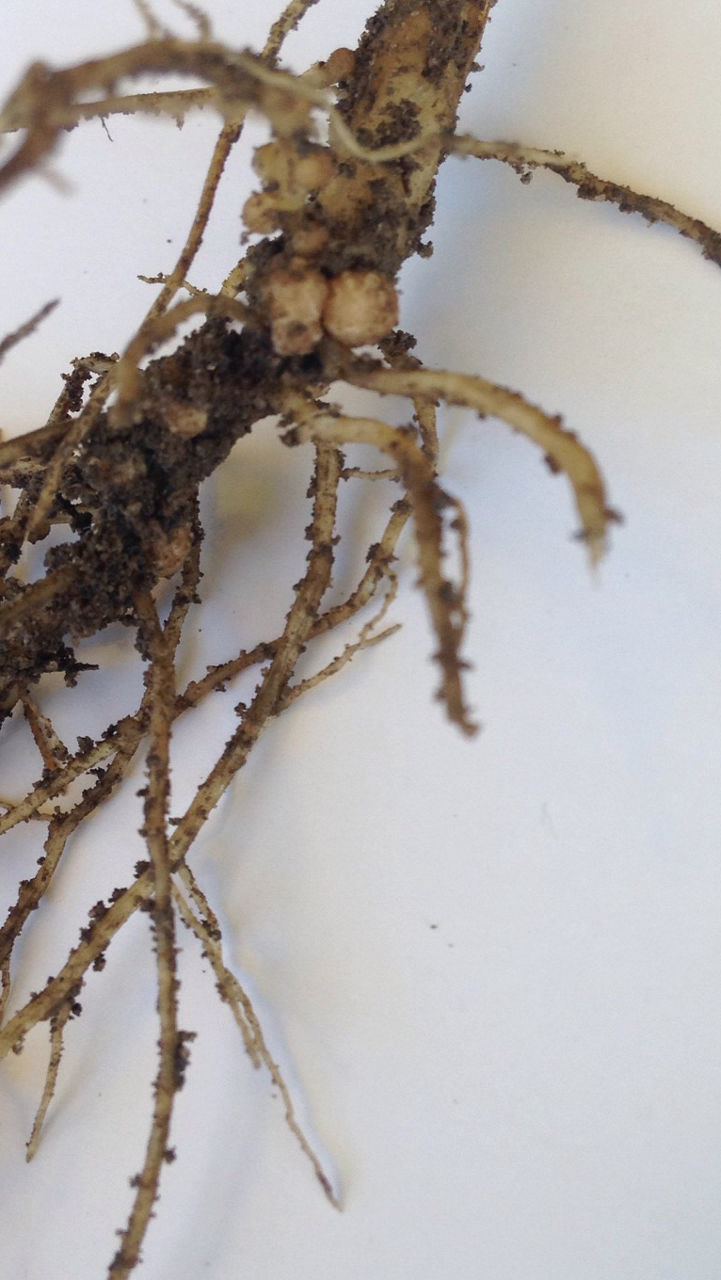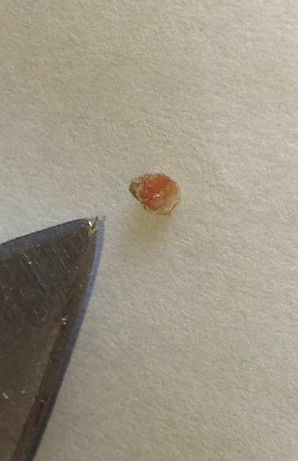5 MIN READ
Plant-Rhizobia Relationship
February 21, 2024
KEY POINTS
- Legumes are common cash crops and cover crops, and include soybeans, alfalfa, peanuts, beans, peas, and clovers.
- Legume plants have a symbiotic relationship with rhizobia soil bacteria
- The symbiotic relationship is mutually beneficial to both the bacteria and plants.
- Rhizobia fix nitrogen. The nitrogen fixation process takes atmospheric nitrogen (N2), which plants cannot use, and transforms into ammonium (NH4), a soil-bound form that plants can use.
- Nitrogen fixation takes place in nodules that form on legume roots.
- The types of rhizobia that can form a symbiotic relationship are specific to a legume species or group of legumes.
- Inoculation is when appropriate rhizobia are deliberately added to the legume seed coat or to the soil before planting to maximize the benefit of nitrogen fixation.
- Other biological inoculation products are also available.
Introduction
Plant-Rhizobia Relationship
Legume plants and rhizobia soil bacteria can form mutually beneficial, symbiotic relationships. The plant roots secrete food for the rhizobia and the rhizobia fix nitrogen for the plant, pulling atmospheric nitrogen from the air and transforming it into soil-bound ammonium (NH4) which the plant can use. Each legume species—or group of legume species—can only be successfully, symbiotically infected by specific species of rhizobia. Farmers can add these specific rhizobia strains to the soil or seed at planting, inoculating their specific crops to help maximize nitrogen fixation and increase yield potential. Improving nitrogen fixation is important because nitrogen is one of the most critical components of crop production, and the nitrogen gas forming approximately 79% of the air is not usable by plants until it is fixed into ammonium by rhizobia.1
Infection
Rhizobia bacteria live in the soil until compatible legume roots become available to infect. When compatible legume roots and rhizobia are present, the rhizobia will begin to multiply and attach to the root hairs of the plant. After they are attached, the rhizobia form an infection thread which allows them to enter the roots.2 Once inside, the plant supplies all the nutrients that are necessary for the rhizobia bacteria and the rhizobia prepare to fix nitrogen for the plant.3
Nodule Development
After the bacteria multiply near the host root and attach, plant tissues surround the rhizobia and form a nodule (Figure 1). Connective tissue then forms between the root and the nodule, allowing food for the rhizobia and NH4 for the plant to pass between the two.2
Nodules vary in size, shape, and color, and can be seen on plant roots about two to three weeks after planting, though timing may vary by legume species and plant growth.3 Young nodules that have not yet started to fix nitrogen are white or greenish grey inside. As nodules grow, they turn pink in the center (Figure 2), indicating that nitrogen fixation has begun. The pink or reddish color is caused by leghemoglobin, which binds with oxygen and transports it away from the nodule, performing a similar function to the hemoglobin in blood.3
There are several environmental conditions that can reduce or impeded nodule formation. These conditions include aluminum toxicity—often caused by low soil pH—high heat, high pH, nutrient deficiencies, waterlogged soils, sandy soils, high residue conditions, soil-available nitrogen, or salinity. The presence of root parasites such as nematodes can also negatively affect nodule formation.6


Nitrogen Fixation
Nitrogen fixation takes place in the root nodules. As mentioned above, this is the process by which rhizobia bacteria convert atmospheric nitrogen gas (N2), which is inaccessible to plants, into a plant-usable form (NH4). The nitrogen fixed by the bacteria is in the same form as the N in ammonium nitrate (34-0-0) and ammonium sulfate (21-0-0) fertilizer.1 Some legumes are better at fixing nitrogen than others. Grain legumes, such as soybean, are typically good at fixing nitrogen and may fix up to 250 lb (113 kg) of nitrogen per acre. Perennial and forage legumes, like alfalfa, can fix 250 to 500 lb (113 to 227 kg) of nitrogen per acre.3 These crops are not typically fertilized with nitrogen fertilizer, except perhaps when they are first established. Even when planted on very sandy or low organic-matter soils, legume crops are often only fertilized with 15 lb per acre (17 kg per ha) or less N to help get the plants started, to carry them through the time in the young plants’ life before the nodules start to produce NH4.3
Factors influencing the amount of nitrogen fixed include the amount of nitrogen in the soil, plant growth, the specific rhizobia strain infecting the legume, soil temperature, and the availability of various micronutrients. If nitrogen is available in the soil, the plant will use that before using the rhizobia bacteria to convert more nitrogen from the air. Anything that reduces plant growth, such as drought or nutrient deficiency, will also reduce nitrogen fixation. Additionally, the strains of rhizobia available are extremely important, as some are much better at fixing nitrogen than others. Soil temperature also influences the rate of nitrogen fixation. The optimum soil temperature range for nitrogen fixation is 55 to 80 °F (13 to 27 °C), and nitrogen fixation does not occur when the soil temperature is less than 48 °F (9 °C). Finally, molybdenum (Mo) is a very important micronutrient for nitrogen fixation. Soil with a pH below 6.0 can have low Mo availability levels, which can be corrected by adding a Mo seed treatment at planting time or applying lime to the soil to raise the pH. Lime applications that adjust the soil pH closer to neutral 7.0 can also improve the availability of other plant nutrients and generally improve conditions for legume growth.5 Under ideal conditions, the amount of nitrogen fixed by the rhizobia bacteria often meets crop needs. Of course, any nitrogen used by the plants is removed from the field when the crop is harvested, but at the end of the annual legume growing season or when a perennial legume crop is terminated there can be nitrogen left over in the soil (N credit) for the following crop to use.1
Inoculation
To help ensure that an effective rhizobia strain is present when planting a legume, the seed should be inoculated with the proper rhizobia stain prior to planting. Many soils contain native strains of rhizobia bacteria, but these strains may vary widely in their ability to fix nitrogen. Less effective strains may produce many small nodules that fix very little nitrogen, whereas effective rhizobia strains form fewer, larger nodules with dark pink centers which indicate healthy and active nitrogen fixation.1
While inoculants do not need to be added every year on every acre—especially when a farmer is planting a corn-soybean crop rotation—they may be beneficial if a field has not been planted to a specific legume in the last five years or after environmental conditions that may have caused the natural rhizobia populations to drop, such as after flooding or drought, extreme temperatures, or in extremely saline or alkaline conditions.4
Rhizobium inoculants contain live bacteria that must be kept healthy to be effective, and therefore they should be stored according to label instructions until the time of use. All rhizobia inoculants have an expiration date and should not be used or purchased if that date has passed. Inoculants can be added to the soil (direct-soil applications) or to the seed (seed-applied inoculants) as a solid, liquid, or as a freeze-dried formualtion.5 Always follow the instructions on the inoculant packages which provide information regarding handling, mixing, the amount of seed or furrow that can be treated, and how and where to store inoculated seed. For additional agronomic information about soybean nodulation and inoculation refer to Factors Influencing Soybean Nodulation | Crop Science US (bayer.us) or contact your Bayer seed representative.
Other Nitrogen-fixing Biological Inoculants for Plant Use
While Rhizobia bacteria are considered the primary symbiotic nitrogen-fixing biological in today’s production agriculture, there are other types of bacteria with known nitrogen-fixing properties which can be used with legumes and other crops. Several non-symbiotic, free-living, nitrogen-fixing bacteria are available for purchase. Depending on the product, these inoculants can be added to the soil at planting, applied to seed, or sprayed on growing crops to increase the bacteria available to provide nitrogen.
Other biological inoculant products may provide additional benefits for plant growth, other than just N fixation. These products do not promise to provide all the nitrogen needed to produce a profitable crop yield but are often marketed as supplemental nitrogen providers that can be used to reduce the amount of N fertilizer needed to grow a profitable crop. As with many new products, questions remain about the performance of these new biologicals and about the management techniques needed to best utilize them. When first using any of these products, consider testing them in a replicated trial format with your management techniques in your production environment. This will allow you to measure their performance and better understand the potential return on your investment. Microbial inoculants have the potential to help farmers meet the growing pressure for more sustainable and environmentally conscious agriculture, especially when it comes to reducing nitrogen fertilization. Unbiased trials, research, and continued efforts to understand the management techniques needed to make these biological products successful can help farmers find ways to be more sustainable while having long term, profitable production.4
Sources:
1 Nitrogen fixation. Texas A&M AgriLife Research & Extension Center at Overton. https://overton.tamu.edu/faculty-staff/gerald-wayne-evers/cool-season-legumes/nitrogen-fixation/
2 Wang, Q., Liu, J., and Zhu, H. 2018. Genetic and molecular mechanisms underlying symbiotic specificity in legume-rhizobium interactions. Frontiers In Plant Science. 9: 313.https://doi.org/10.3389/fpls.2018.00313
3 Lindemann, W. and Glover, C. 2015. Nitrogen fixation by legumes. New Mexico State University. Guide A-129. https://pubs.nmsu.edu/_a/A129/
42023. Fixing our perspective on N-fixing. 3Bar Biologics. https://www.3barbiologics.com/2023/06/fixing-our-perspective-on-n-fixing-full-article/
5 Erker, B. and Brick, M.A. 2014. Legume seed inoculants – 0.305. Colorado State University Extension. https://extension.colostate.edu/topic-areas/agriculture/legume-seed-inoculants-0-305/
6 Nitrogen fixing bacteria. Soil Health. http://www.soilhealth.com/soil-health/biology/beneficial/rhizobia/index.htm
Web sources verified 2/8/24 1317_97645